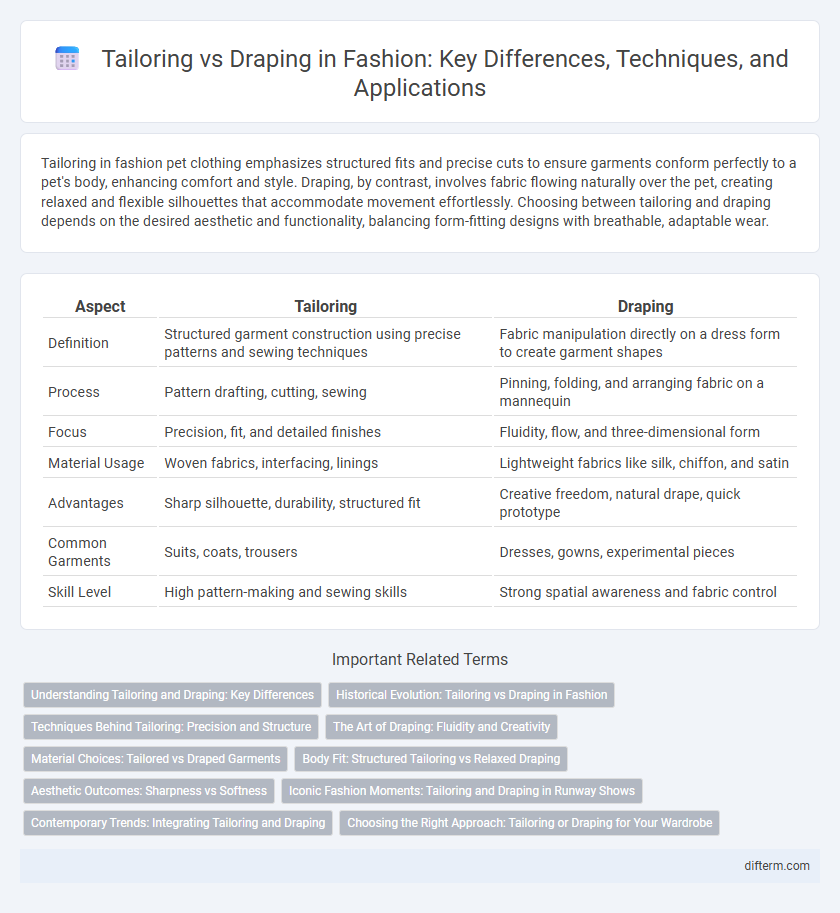Tailoring in fashion pet clothing emphasizes structured fits and precise cuts to ensure garments conform perfectly to a pet's body, enhancing comfort and style. Draping, by contrast, involves fabric flowing naturally over the pet, creating relaxed and flexible silhouettes that accommodate movement effortlessly. Choosing between tailoring and draping depends on the desired aesthetic and functionality, balancing form-fitting designs with breathable, adaptable wear.
Table of Comparison
| Aspect | Tailoring | Draping |
|---|---|---|
| Definition | Structured garment construction using precise patterns and sewing techniques | Fabric manipulation directly on a dress form to create garment shapes |
| Process | Pattern drafting, cutting, sewing | Pinning, folding, and arranging fabric on a mannequin |
| Focus | Precision, fit, and detailed finishes | Fluidity, flow, and three-dimensional form |
| Material Usage | Woven fabrics, interfacing, linings | Lightweight fabrics like silk, chiffon, and satin |
| Advantages | Sharp silhouette, durability, structured fit | Creative freedom, natural drape, quick prototype |
| Common Garments | Suits, coats, trousers | Dresses, gowns, experimental pieces |
| Skill Level | High pattern-making and sewing skills | Strong spatial awareness and fabric control |
Understanding Tailoring and Draping: Key Differences
Tailoring involves precise pattern making and construction techniques to create structured, fitted garments that emphasize clean lines and durability, often requiring skilled sewing and fitting adjustments. Draping, on the other hand, is a creative process where fabric is pinned and arranged directly on a dress form to explore shapes and flow, resulting in soft, fluid designs that highlight fabric texture and movement. Understanding these approaches allows designers to choose the best method for achieving desired aesthetics, fit, and fabric behavior in fashion design.
Historical Evolution: Tailoring vs Draping in Fashion
Tailoring and draping have distinct historical roots that shaped fashion evolution; tailoring, originating from structured garment construction in Medieval Europe, emphasized precision and symmetry through sewing techniques. Draping, with ancient origins in cultures like Greece and India, relied on fabric manipulation to create flowing, organic silhouettes without extensive stitching. The contrast between tailored garments' rigid formality and draped textiles' fluid elegance reflects shifting cultural values and technological advancements throughout fashion history.
Techniques Behind Tailoring: Precision and Structure
Tailoring relies on precision measurements and structured sewing techniques to create garments that fit the body perfectly, emphasizing clean lines and defined shapes. The use of darts, seams, and interfacing ensures durability and a polished finish, distinguishing tailored pieces from more fluid designs. Skilled tailors balance fabric tension and garment architecture to produce sophisticated, form-fitting attire.
The Art of Draping: Fluidity and Creativity
The art of draping in fashion emphasizes fluidity and creativity by allowing fabric to flow naturally over the form, creating organic shapes and unique silhouettes. Unlike tailoring, which relies on precise measurements and structured seams, draping encourages improvisation, enabling designers to experiment with texture, weight, and movement. This technique highlights the versatility of fabrics such as silk, chiffon, and jersey, transforming raw materials into wearable art through a hands-on, artistic process.
Material Choices: Tailored vs Draped Garments
Tailored garments often utilize structured materials like wool, tweed, and cotton blends that hold shape and provide crisp lines essential for precise cuts and fitting. Draped garments favor fluid, lightweight fabrics such as silk, chiffon, and jersey, allowing natural folds and soft contouring around the body. Textile properties including weight, stiffness, and stretchability critically influence whether a fabric is suited for tailored or draped fashion designs.
Body Fit: Structured Tailoring vs Relaxed Draping
Structured tailoring emphasizes precise body fit through measured cuts and firm seams, creating sharp silhouettes that enhance body contours. Relaxed draping offers a softer, more fluid fit by using lightweight fabrics that gently flow over the body, prioritizing comfort and movement. Tailoring defines shape with rigidity, while draping embraces natural form with ease.
Aesthetic Outcomes: Sharpness vs Softness
Tailoring achieves sharpness through precise cuts and structured seams, creating clean lines and defined silhouettes that emphasize form and symmetry. Draping yields softness by allowing fabric to flow naturally over the body, producing fluid shapes and gentle contours that enhance movement and grace. The choice between tailoring and draping ultimately shapes a garment's aesthetic impact, balancing rigidity with fluidity to define the wearer's style.
Iconic Fashion Moments: Tailoring and Draping in Runway Shows
Tailoring and draping have defined iconic fashion moments by shaping the silhouette and movement of garments on the runway. Tailoring emphasizes structured, precise cuts that create sharp lines and a polished look, exemplified by designers like Giorgio Armani and Alexander McQueen. Draping introduces fluidity and softness through expertly manipulated fabric, showcased in shows by designers such as Madame Gres and Valentino, highlighting the balance between form and freedom in high fashion.
Contemporary Trends: Integrating Tailoring and Draping
Contemporary fashion trends emphasize the seamless integration of tailoring and draping to create garments that balance structure and fluidity, enhancing both silhouette and movement. Designers increasingly experiment with hybrid techniques, combining precise tailoring's sharp lines and draping's soft, flowing fabrics to innovate modern aesthetics. This approach results in versatile clothing that appeals to consumers seeking both sophistication and comfort in their wardrobe.
Choosing the Right Approach: Tailoring or Draping for Your Wardrobe
Choosing between tailoring and draping hinges on the desired fit and fabric type; tailoring offers precise, structured garments ideal for sharp silhouettes, while draping provides fluidity and softness suited to lightweight, flowing textiles. Tailoring involves detailed pattern making and sewing techniques that enhance durability and form, making it perfect for formal wear or structured suits. Draping emphasizes creativity and adaptability by shaping fabric directly on the mannequin, often favored in haute couture and experimental fashion for its organic, sculptural qualities.
tailoring vs draping Infographic

 difterm.com
difterm.com